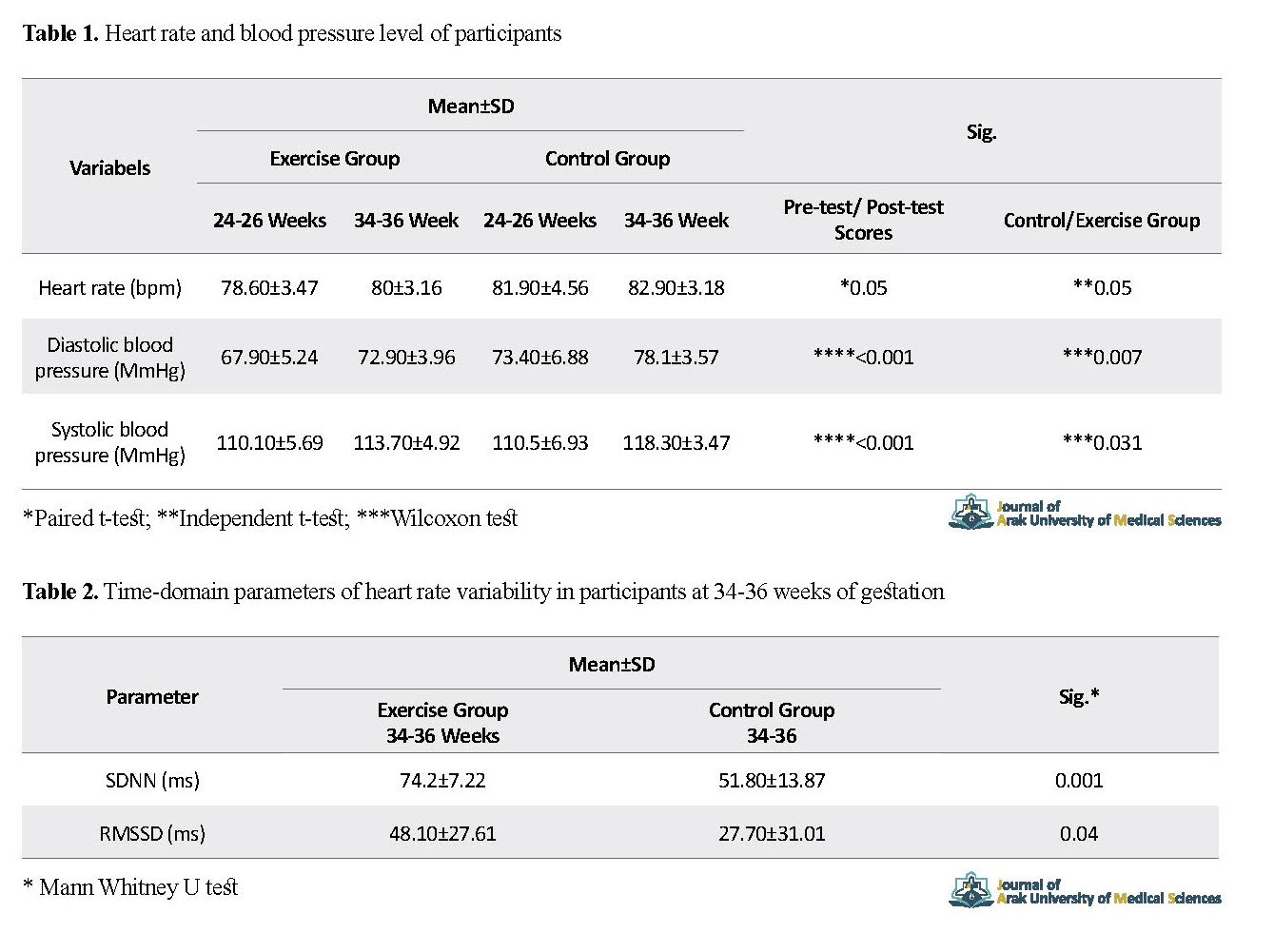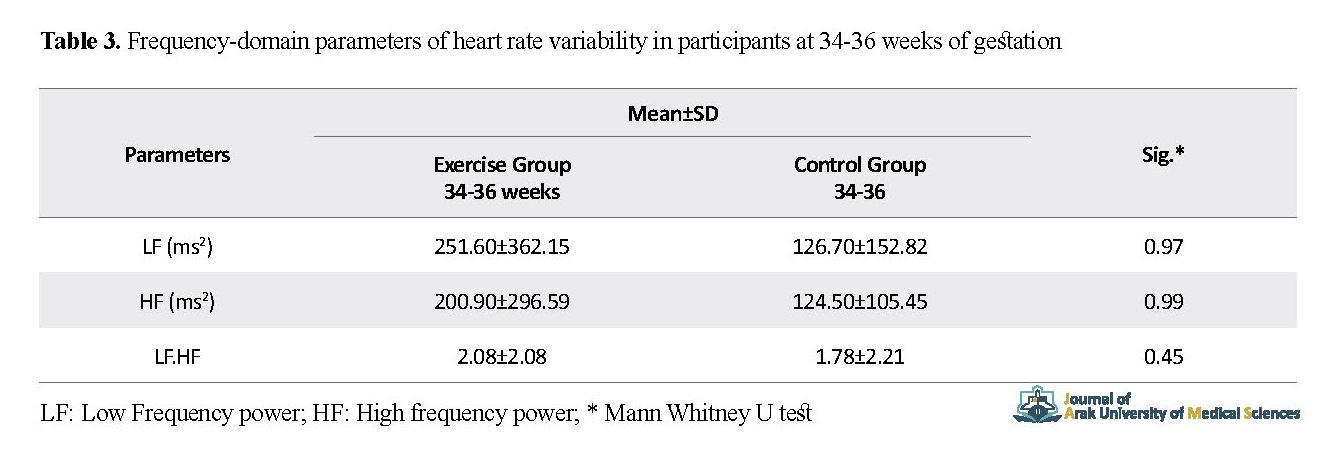Volume 22, Issue 6 (February & March 2020)
J Arak Uni Med Sci 2020, 22(6): 230-241 |
Back to browse issues page
Download citation:
BibTeX | RIS | EndNote | Medlars | ProCite | Reference Manager | RefWorks
Send citation to:



BibTeX | RIS | EndNote | Medlars | ProCite | Reference Manager | RefWorks
Send citation to:
Ahrari K, Gholami M, Chamani M, Abednatanzi H. Effects of a Combined Aerobic and Resistant Exercise Training Program on Blood Pressure and Heart Rate Variability in Pregnant Women: A Randomized Clinical Trial. J Arak Uni Med Sci 2020; 22 (6) :230-241
URL: http://jams.arakmu.ac.ir/article-1-6177-en.html
URL: http://jams.arakmu.ac.ir/article-1-6177-en.html
1- Department of Physical Education & Sport Sciences, Faculty of Literature, Humanities and Social Sciences, Science and Research Branch, Islamic Azad University, Tehran, Iran.
2- Department of Physical Education & Sport Sciences, Faculty of Literature, Humanities and Social Sciences, Science and Research Branch, Islamic Azad University, Tehran, Iran. , m.gholami@srbiau.ac.ir
3- Department of Obstetrics and Gynecology, Shahid Akbarabadi Hospital, Clinical Research Development Unit (ShAcrdu), Iran University of Medical Sciences, Tehran, Iran.
2- Department of Physical Education & Sport Sciences, Faculty of Literature, Humanities and Social Sciences, Science and Research Branch, Islamic Azad University, Tehran, Iran. , m.gholami@srbiau.ac.ir
3- Department of Obstetrics and Gynecology, Shahid Akbarabadi Hospital, Clinical Research Development Unit (ShAcrdu), Iran University of Medical Sciences, Tehran, Iran.
Full-Text [PDF 3138 kb]
(2173 Downloads)
| Abstract (HTML) (3177 Views)
Full-Text: (4959 Views)
Extended Abstract
Introduction
Pregnancy and exercise training are associated with changes in the cardiovascular anatomy and physiology. Today, the demand of pregnant women to participate in exercise activities has increased, and various studies have emphasized the combination of different types of exercises, especially aerobic and resistance exercises, to obtain better results [3]. The effect of exercise on the cardiovascular system of the mother and fetus according to their different protocols and the main criteria of prescribing exercise has not been adequately investigated with appropriate methodology in the world and especially in Iran. Moreover, in previous limited studies, contradictory results have been reported on cardiovascular hemodynamic changes and parameters of maternal and fetal heart rate variability following exercise training [5, 6]. In this regard, this study aimed to investigate the effect of a combined aerobic and resistance exercises training program on blood pressure and heart rate variability in pregnant women.
Materials and Methods
This study is a single-blind, parallel-group, two-stage randomized clinical trial. The study population consisted of all healthy pregnant women referred to Shahid Akbarabadi Hospital in Tehran, Iran in 2019. Inclusion criteria for participants were: Age 20 to 35 years, singleton pregnancy, body mass index of 18.5-25, pregnancy frequency less than 5, and blood pressure <140.90. Cardiovascular and orthopedic diseases, pregnancy complications and having a history of high risk pregnancy were exclusion criteria. Based on these criteria, 20 samples were selected and randomly divided into two groups of exercise (n=10) and control (n=10). The exercise group received combined exercise training for 8 weeks, 3 sessions per week at moderate intensity from the week 24-26 of gestation. Exercise tests, anthropometric measurements, blood pressure, and electrocardiogram test were performed before and after intervention. AST3000 Avicenna software was used to analyze the heart rate variability parameters. For statistical analysis, paired and independent t-tests, Mann Whitney U, Fisher’s test, Shapiro-Wilk test and Wilcoxon tests were used in SPSS v. 24 sofwtare.
Results
According to the findings, there was no statistically significant difference in age, height, weight, body mass index, body fat percentage, maximum oxygen consumption, education, number of deliveries, and physical activity between the exercise and control groups (p>0.05). Before combined exercise, resting heart rate, systolic and diastolic blood pressures were similar in the two groups (P>0.05), but the mean of these variables were significantly lower in the exercise group after eight weeks of combined exercise training (P<0.05). Moreover, in both groups, the mean diastolic and systolic blood pressures were significantly higher at 34-36 weeks of gestation than at 24-26 weeks (P<0.05) (Table 1). Comparing the results of the exercise group before and after intervention, the Standard Deviation of NN intervals (SDNN) in pregnant women at 34-36 weeks of gestation was higher than that at 24-26 weeks of gestation (P<0.05). The mean of time-domain parameters including SDNN and Root Mean Square of Successive Differences (RMSSD) in the exercise group were higher at the 34th week of pregnancy compared to the control group (P<0.05) (Tables 2 and 3).
Introduction
Pregnancy and exercise training are associated with changes in the cardiovascular anatomy and physiology. Today, the demand of pregnant women to participate in exercise activities has increased, and various studies have emphasized the combination of different types of exercises, especially aerobic and resistance exercises, to obtain better results [3]. The effect of exercise on the cardiovascular system of the mother and fetus according to their different protocols and the main criteria of prescribing exercise has not been adequately investigated with appropriate methodology in the world and especially in Iran. Moreover, in previous limited studies, contradictory results have been reported on cardiovascular hemodynamic changes and parameters of maternal and fetal heart rate variability following exercise training [5, 6]. In this regard, this study aimed to investigate the effect of a combined aerobic and resistance exercises training program on blood pressure and heart rate variability in pregnant women.
Materials and Methods
This study is a single-blind, parallel-group, two-stage randomized clinical trial. The study population consisted of all healthy pregnant women referred to Shahid Akbarabadi Hospital in Tehran, Iran in 2019. Inclusion criteria for participants were: Age 20 to 35 years, singleton pregnancy, body mass index of 18.5-25, pregnancy frequency less than 5, and blood pressure <140.90. Cardiovascular and orthopedic diseases, pregnancy complications and having a history of high risk pregnancy were exclusion criteria. Based on these criteria, 20 samples were selected and randomly divided into two groups of exercise (n=10) and control (n=10). The exercise group received combined exercise training for 8 weeks, 3 sessions per week at moderate intensity from the week 24-26 of gestation. Exercise tests, anthropometric measurements, blood pressure, and electrocardiogram test were performed before and after intervention. AST3000 Avicenna software was used to analyze the heart rate variability parameters. For statistical analysis, paired and independent t-tests, Mann Whitney U, Fisher’s test, Shapiro-Wilk test and Wilcoxon tests were used in SPSS v. 24 sofwtare.
Results
According to the findings, there was no statistically significant difference in age, height, weight, body mass index, body fat percentage, maximum oxygen consumption, education, number of deliveries, and physical activity between the exercise and control groups (p>0.05). Before combined exercise, resting heart rate, systolic and diastolic blood pressures were similar in the two groups (P>0.05), but the mean of these variables were significantly lower in the exercise group after eight weeks of combined exercise training (P<0.05). Moreover, in both groups, the mean diastolic and systolic blood pressures were significantly higher at 34-36 weeks of gestation than at 24-26 weeks (P<0.05) (Table 1). Comparing the results of the exercise group before and after intervention, the Standard Deviation of NN intervals (SDNN) in pregnant women at 34-36 weeks of gestation was higher than that at 24-26 weeks of gestation (P<0.05). The mean of time-domain parameters including SDNN and Root Mean Square of Successive Differences (RMSSD) in the exercise group were higher at the 34th week of pregnancy compared to the control group (P<0.05) (Tables 2 and 3).
Discussion
Based on the findings of this study, the mean of heart rate, systolic blood pressure and diastolic blood pressure in pregnant women received 8 weeks of combined exercise were lower than in controls. Decreased vasomotor tone, increased parasympathetic neural activity, and mediators such as nitric oxide following exercise may be the reasons for lower blood pressure and heart rate in the exercise group than in the control group [15].
Based on the findings of this study, the mean of heart rate, systolic blood pressure and diastolic blood pressure in pregnant women received 8 weeks of combined exercise were lower than in controls. Decreased vasomotor tone, increased parasympathetic neural activity, and mediators such as nitric oxide following exercise may be the reasons for lower blood pressure and heart rate in the exercise group than in the control group [15].
Increased SDNN parameter in the exercise group compared to the control group indicates that combined exercise improves the autonomic nervous system balance. However, in pregnancy, the parameters of heart rate variability decrease or do not change with increasing gestational age and increasing weight of pregnant women [4]. In this study, the RSMMD parameter was higher in trained pregnant women and in 34-36 weeks of pregnancy compared to the control group. This difference was statistically significant. In other words, combined exercise resulted in the relatively high parasympathetic nerve activity in the exercise group [5]. May et al. also reported the mean increase in heart rate variability of pregnant women performed exercise training [5, 20]. Their study was a case-control study, so there was a possibility of confounding effects. In Satyapriya et al.’s study, two groups of pregnant women with different exercises were studied. In two groups, HF increased and LF and LF / HF decreased; however, no control group was included in their study [22]. The reason for the discrepancies between the results of this study and others can be the difference in the number of samples, the order of exercise, body weight, and gestational age [5, 6].
Conclusion
The combined exercise training group can improve heart rate, blood pressure and heart rate variability in pregnant women. Further studies are recommended to investigate the effects of combined exercises with different intensity and the mechanism of their effects on blood pressure and heart rate variability.
Ethical Considerations
Compliance with ethical guidelines
This study with registered clinical trial code IRCT20190227042856N1 was approved by the Research Ethics Committee of Islamic Azad University of Science and Research Branch in Tehran, Iran (code: IR.IAU.SRB.REC.1397.101).
Funding
This study was extracted from thesis of the first author, Khadijeh Ahrari, approved by the Department of Physical Education and Sports Science, Islamic Azad University, Science and Research Branch.
Authors' contributions
All authors met the standards of writing based on the recommendations of the International Committee of Medical Journal Editors (ICMJE).
Conflicts of interest
The authors declare no conflict of interest.
Acknowledgements
The authors would like to thank the faculty professors, the staff of Perinatology Clinic and Clinical Research Development Unit of Shahid Akbarabadi Hospital in Tehran.
Conclusion
The combined exercise training group can improve heart rate, blood pressure and heart rate variability in pregnant women. Further studies are recommended to investigate the effects of combined exercises with different intensity and the mechanism of their effects on blood pressure and heart rate variability.
Ethical Considerations
Compliance with ethical guidelines
This study with registered clinical trial code IRCT20190227042856N1 was approved by the Research Ethics Committee of Islamic Azad University of Science and Research Branch in Tehran, Iran (code: IR.IAU.SRB.REC.1397.101).
Funding
This study was extracted from thesis of the first author, Khadijeh Ahrari, approved by the Department of Physical Education and Sports Science, Islamic Azad University, Science and Research Branch.
Authors' contributions
All authors met the standards of writing based on the recommendations of the International Committee of Medical Journal Editors (ICMJE).
Conflicts of interest
The authors declare no conflict of interest.
Acknowledgements
The authors would like to thank the faculty professors, the staff of Perinatology Clinic and Clinical Research Development Unit of Shahid Akbarabadi Hospital in Tehran.
Type of Study: Original Atricle |
Subject:
Obstetrics & Gynocology
Received: 2019/10/25 | Accepted: 2019/12/28
Received: 2019/10/25 | Accepted: 2019/12/28
Send email to the article author
| Rights and permissions | |
 |
This work is licensed under a Creative Commons Attribution-NonCommercial 4.0 International License. |











